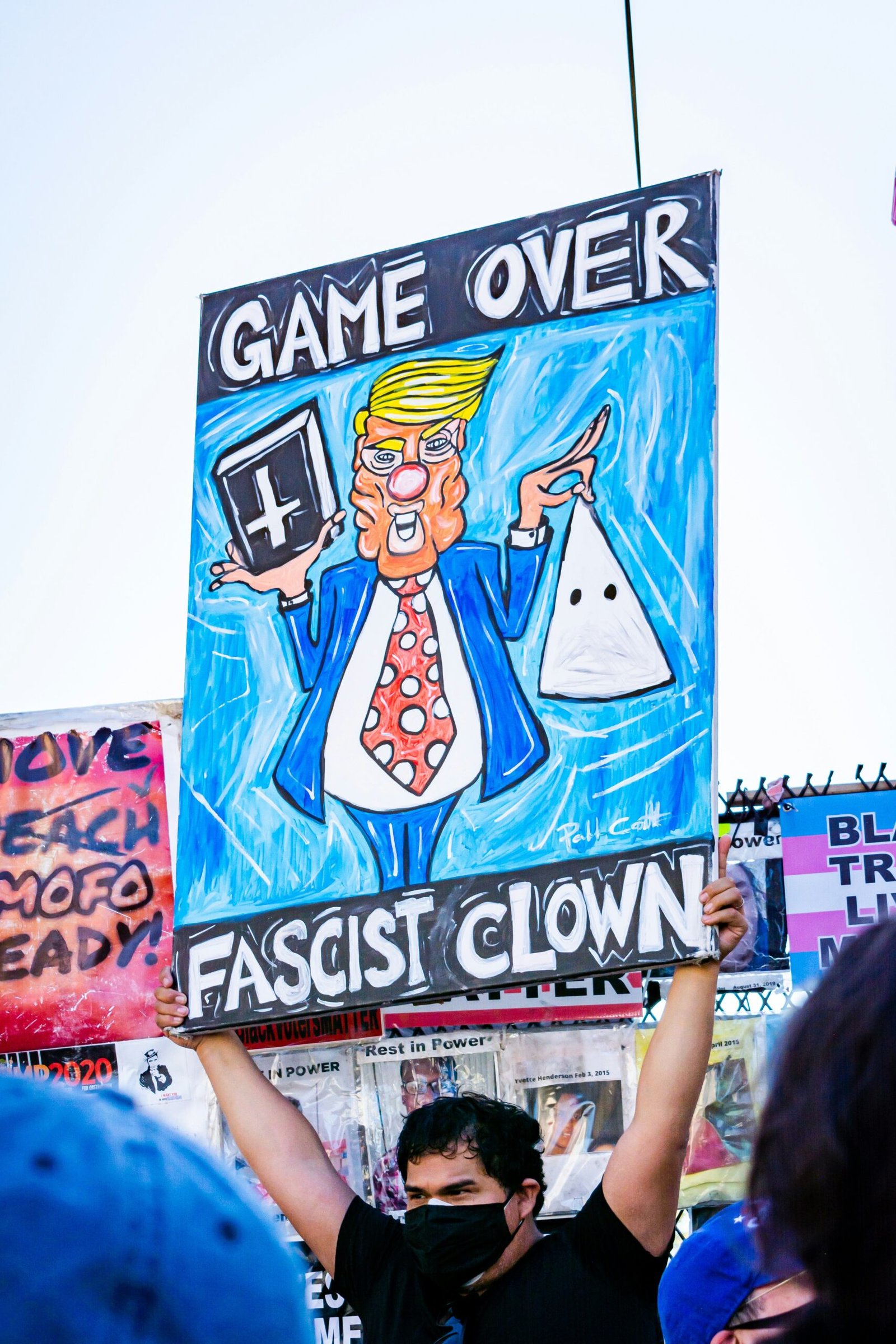
Contents
Introduction to American Fascism
Fascism, a political ideology that emerged in the early 20th century, is characterized by authoritarianism, extreme nationalism, and the suppression of dissent. Historically, fascism gained prominence in Europe, most notably under the regimes of Benito Mussolini in Italy and Adolf Hitler in Germany. These regimes were marked by dictatorial power, centralized control, and the aggressive elimination of opposition, often through violent means.
Globally, fascism has manifested in various forms, adapting to local contexts and political landscapes. While the core tenets of authoritarian control, fervent nationalism, and the suppression of political dissidents remain consistent, the specific attributes and policies of fascist regimes can differ significantly. In some nations, fascism has intertwined with existing political structures and cultural narratives, creating unique iterations of the ideology.
In the context of American society, the evolution of fascism has been complex and multifaceted. Although the United States has never experienced a fascist regime akin to those seen in Europe, elements of fascist ideology have periodically surfaced within its political landscape. These manifestations often emerge in response to social, economic, or political crises, where appeals to strong leadership, national unity, and the vilification of perceived enemies gain traction.

Key characteristics of fascism in the American context include a strong emphasis on nationalism, which often translates into exclusionary policies and rhetoric aimed at marginalized groups. Authoritarian tendencies can also be observed in efforts to centralize power, undermine democratic institutions, and curtail civil liberties. Additionally, the suppression of dissent plays a critical role, with tactics ranging from media manipulation and propaganda to more direct forms of intimidation and violence against political opponents.
Understanding the historical roots and defining features of fascism is essential for recognizing its presence and potential impact within American society. By examining how fascism has evolved and adapted over time, we can better comprehend the challenges it poses to democratic principles and the importance of safeguarding against its insidious influence.
Historical Context of Fascism in America
The development of fascist ideologies in America can be traced back to the early 20th century. During this period, the United States was experiencing significant social and economic changes, which created fertile ground for extremist ideologies. The rise of industrialization and urbanization led to a sense of disorientation among many Americans who felt left behind by rapid progress. This environment facilitated the emergence of groups such as the Ku Klux Klan (KKK), which promoted fascist ideas under the guise of nationalism and racial purity. The KKK’s influence peaked in the 1920s, boasting millions of members and significant political power, although it was met with both public and governmental resistance.
The influence of World War II further shaped the trajectory of fascism in America. The war’s global context and the fight against totalitarian regimes abroad highlighted the dangers of fascist ideologies. However, it also led to the rise of domestic groups that sympathized with fascist principles, such as the German American Bund. This organization sought to promote Nazi sympathies within the United States, organizing rallies and advocating for a pro-Hitler stance. The American public and government responded with strong opposition, leading to the eventual decline of such groups post-war.
In the subsequent decades, the civil rights era marked another pivotal moment in the history of American fascism. The fight for racial equality and the significant strides made by civil rights activists were met with fierce opposition from various extremist groups. Organizations like the American Nazi Party, founded by George Lincoln Rockwell in 1959, sought to capitalize on the social unrest by promoting white supremacist and anti-Semitic ideologies. These groups often faced substantial pushback from the public and were subjected to governmental scrutiny and legal actions.
Throughout these periods, key figures and movements have attempted to advance fascist ideologies in America, with varying degrees of success. The public and governmental responses have generally been characterized by opposition and efforts to curb the influence of such groups. Understanding this historical context is crucial for comprehending the complexities of fascism’s presence in American society.
In the modern age, propaganda and media play pivotal roles in the dissemination of fascist ideologies in America. The strategic use of media outlets and social media platforms has enabled the spread of misinformation and extremist rhetoric, shaping public perception and influencing behavior on a large scale. This manipulation of information serves as a powerful tool in the arsenal of those aiming to propagate fascist ideologies.
Historically, propaganda has been employed to create a unified narrative that aligns with fascist beliefs. In recent times, certain media outlets have been criticized for presenting biased news that supports extremist views. For instance, some television networks and online news sites have been accused of spreading conspiracy theories and false information, which can exacerbate societal divisions and foster an environment conducive to fascist ideologies.
Social media platforms have also become fertile ground for the spread of fascist rhetoric. The algorithms that drive these platforms often prioritize content that generates strong emotional reactions, which can include fear, anger, and hatred. This has led to the proliferation of misinformation and divisive content, as users are more likely to engage with sensationalist posts. Influential figures, including politicians and media personalities, have exploited these platforms to amplify their messages, often blurring the lines between fact and fiction.
The psychological impact of propaganda on the public is profound. Repeated exposure to biased information can create a skewed perception of reality, leading individuals to adopt extremist views. This phenomenon, known as the “echo chamber effect,” occurs when people are exposed only to information that reinforces their preexisting beliefs. Sociologically, this can result in increased polarization within society, as groups become more entrenched in their ideological positions and less willing to engage in constructive dialogue.
In conclusion, the role of propaganda and media in promoting fascist ideologies in America cannot be underestimated. By understanding the mechanisms through which misinformation and extremist rhetoric are spread, we can better equip ourselves to combat these dangerous influences and foster a more informed and cohesive society.
Political Strategies of Fascist Movements
Fascist movements in America have consistently employed a variety of political strategies to gain and maintain power. One of the most prominent tactics is fear-mongering. By stoking fears about perceived threats, whether they be from immigrants, minority groups, or foreign entities, fascist leaders create an atmosphere of urgency and crisis. This tactic serves to rally support by presenting the leaders as the sole protectors against these exaggerated dangers. The use of alarmist rhetoric and sensationalized media helps to sustain a state of perpetual fear, which in turn justifies authoritarian measures.
Scapegoating is another common strategy. By blaming societal problems on specific groups, fascist movements divert attention from systemic issues and foster division. This approach not only alienates targeted groups but also unites the majority against a common enemy. Historical and contemporary examples include the vilification of racial minorities, immigrants, and political dissidents. These groups are often portrayed as threats to national security and cultural identity, thus justifying harsh policies and actions against them.
Manipulation of democratic processes is a hallmark of fascist political strategy. This can include undermining electoral integrity, eroding checks and balances, and consolidating power in the executive branch. Voter suppression tactics, such as stringent ID laws and gerrymandering, are employed to disenfranchise opposition supporters. Additionally, fascist movements often attack the press and judiciary to weaken these institutions’ ability to hold leaders accountable. By discrediting these pillars of democracy, fascist leaders can operate with greater impunity.
Specific policies and actions taken by political leaders that align with fascist principles include aggressive immigration enforcement, curtailing civil liberties, and promoting a nationalist agenda. These policies are often justified under the guise of national security, economic stability, or cultural preservation. Leaders may frame their actions as necessary for protecting the nation, even as they erode democratic norms and institutions. Through these strategies, fascist movements seek to concentrate power and suppress dissent, ultimately undermining the democratic foundations of society.
The economic landscape plays a pivotal role in shaping political ideologies and movements, with fascism being no exception. Economic instability, marked by uneven wealth distribution, high unemployment rates, and financial crises, often serves as fertile ground for the rise of fascist movements. Such conditions breed discontent among the populace, which can then be leveraged by fascist leaders to gain support by promising stability, employment, and national rejuvenation.
Throughout American history, periods of economic turmoil have frequently been exploited to justify fascist rhetoric and policies. For instance, during the Great Depression of the 1930s, the severe economic downturn led to widespread unemployment and poverty. This created a vacuum that fascist and authoritarian groups attempted to fill by promoting ideologies centered on strong, centralized control and the scapegoating of marginalized communities as the cause of economic woes. Figures like Father Charles Coughlin used economic grievances to rally support for authoritarian policies, presenting themselves as protectors of the common man against a corrupted elite.
More recently, the 2008 financial crisis, which resulted in massive job losses and housing market collapses, once again highlighted the vulnerability of the economic system. The resulting economic disparity and feelings of disenfranchisement among middle and working-class Americans provided a fertile ground for populist and nationalist rhetoric. Movements that flirted with fascist ideologies took advantage of this discontent, emphasizing themes of economic nationalism and protectionism as solutions to economic instability.
Economic inequality, in particular, can exacerbate social tensions, making it easier for fascist movements to draw a stark contrast between the ‘pure’ populace and the ‘corrupt’ elites. By promising economic reforms that prioritize national interests over global cooperation, these movements can appeal to those who feel left behind by the current economic framework. The cyclical nature of economic instability and the exploitation of these conditions underscore the persistent threat of fascism in times of economic crisis.
The Politics of Illusion: Creating an Alternate Reality
The politics of illusion operates on the principle of distorting reality to align with fascist agendas. This manipulation is achieved through the dissemination of conspiracy theories, fake news, and alternative facts, which collectively construct a parallel reality that resonates with and reinforces fascist ideologies. By undermining objective truths, these tactics create a fertile ground for authoritarian control and erode public trust in democratic institutions.
Conspiracy theories play a pivotal role in the politics of illusion. They offer simplistic explanations for complex societal issues, often attributing them to nefarious plots by perceived enemies. For example, the QAnon conspiracy, which posits that a secret cabal of elites is controlling world events, has gained significant traction in recent years. This theory has been embraced by various far-right groups, as it offers a narrative that justifies their worldview and actions.
Fake news is another tool used to shape this alternate reality. By spreading misinformation and disinformation, those in power can control the narrative and influence public opinion. The 2016 U.S. Presidential election is a notable example, where false stories about candidates were widely circulated online, swaying voter perceptions and decisions. This manipulation of information not only distorts reality but also polarizes the populace, creating an “us versus them” mentality that is a hallmark of fascist regimes.
Alternative facts further contribute to the construction of a parallel reality. This term, popularized during the Trump administration, refers to the presentation of falsehoods as legitimate alternative viewpoints. By promoting alternative facts, leaders can dismiss inconvenient truths and legitimize their preferred narratives. This tactic was evident in the response to the COVID-19 pandemic, where conflicting information about the virus and its severity created confusion and hindered effective public health measures.
The impact of these strategies on public discourse is profound. They foster a climate of skepticism and division, weakening the foundations of democratic engagement. When citizens cannot agree on basic facts, meaningful dialogue and consensus-building become nearly impossible. This erosion of shared reality paves the way for authoritarianism, as people become more susceptible to demagoguery and less capable of holding leaders accountable.
Resistance and Counteraction
The rise of fascist ideologies in America has been met with significant resistance from various sectors of society. Civil society has played a crucial role in counteracting these pernicious ideologies through organized efforts and advocacy. Grassroots organizations have emerged as powerful agents of change, mobilizing communities and raising awareness about the dangers of fascism. These organizations often operate at the local level, fostering a sense of community and solidarity that is essential for effective resistance.
Political leaders have also been instrumental in the fight against fascism. Many have used their platforms to denounce authoritarian tendencies and promote democratic values. For instance, lawmakers have introduced legislation aimed at curbing hate speech and violence, while also pushing for policies that promote inclusivity and social justice. The active involvement of political leaders is critical, as it lends legitimacy and visibility to the resistance movement.
Successful resistance strategies often involve a combination of public protests, legal action, and advocacy. Public demonstrations have historically been effective in drawing attention to fascist activities and galvanizing public opinion against them. Legal challenges, on the other hand, have been pivotal in dismantling structures that support fascist ideologies. For example, court rulings that strike down discriminatory laws or policies serve as significant victories for the resistance movement.
Advocacy and education are other vital components of counteraction. Organizations dedicated to educating the public about the signs and dangers of fascism help build a more informed and vigilant populace. Educational campaigns, workshops, and seminars are commonly used to disseminate this crucial information, empowering individuals to recognize and resist fascist tendencies in their communities.
The importance of vigilance and proactive measures cannot be overstated. Combating fascism requires constant effort and a multifaceted approach. By remaining vigilant and taking proactive steps, society can create a resilient defense against the encroachment of fascist ideologies. The collective efforts of civil society, grassroots organizations, and political leaders underscore the enduring commitment to preserving democratic values and human rights.
Conclusion: The Future of Fascism in America
Throughout the blog post, we have delved into the intricate dynamics of American fascism, examining its historical roots, contemporary manifestations, and the sociopolitical factors that fuel its growth. The analysis has underscored the multifaceted nature of fascism in the United States, revealing how it evolves and adapts to changing circumstances. This exploration has highlighted the importance of recognizing the signs of fascism and understanding how it can subtly infiltrate political discourse and societal norms.
The current state of fascism in America is marked by a troubling blend of political polarization, economic disparity, and cultural fragmentation. The rise of authoritarian rhetoric, coupled with the erosion of democratic institutions, presents a significant challenge to maintaining a free and open society. These conditions create fertile ground for fascist ideologies to take root, often masquerading under the guise of populism or nationalism. It is crucial to remain vigilant and critically assess political movements and their underlying motivations.
Looking forward, the potential future scenarios of fascism in America hinge largely on the collective response of its citizens. Education, awareness, and civic engagement are paramount in countering the spread of fascist ideologies. By fostering a well-informed and active citizenry, we can fortify democratic values and uphold human rights. Educational initiatives that promote critical thinking and historical awareness are essential in debunking fascist propaganda and preventing its normalization.
Civic engagement plays a pivotal role in safeguarding democracy. Encouraging participation in local and national elections, supporting policies that promote social justice and economic equality, and standing against hate and bigotry are vital actions. By staying informed and actively engaging in the political process, individuals can make significant contributions to the fight against fascism.
In conclusion, the future of fascism in America is not predetermined. It is shaped by the actions and decisions of its people. By prioritizing education, fostering awareness, and promoting active civic participation, we can work towards a society that values democracy, equality, and human rights. Let us remain steadfast in our commitment to these principles, ensuring a resilient and inclusive future for all.
OUR SITE: toinewsalert.com





